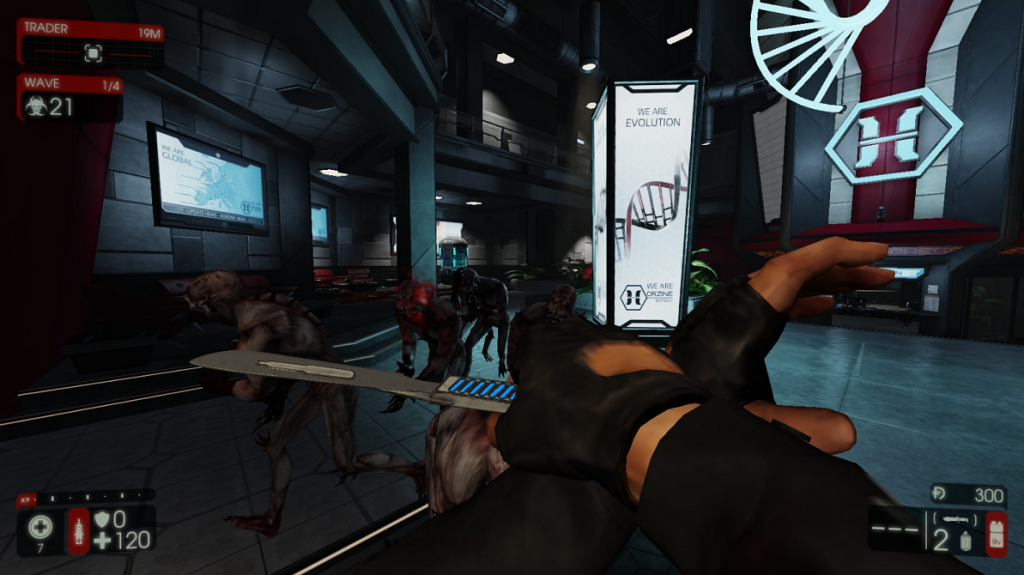Flooricide
Killing Floor 2 came out recently, and I’ve taken the opportunity to take my first steps into the Killing Floor franchise. For someone who’s spent a significant amount of my gaming time perfecting my ability and understanding of Left 4 Dead 2 and Payday:The Heist, it’s a bit odd for me to avoid the third member of Steam’s horde-based co-op triumvirate. But I’d never liked how the objective was literally killing the zombies (or Zeds, to be politically correct.) I prefer my enemies to be an obstacle preventing me from achieving a more global objective, like reaching the next safe room or breaking into a vault, since it gives the game more of a narrative and organically encourages team roles through gameplay (someone can focus on objectives while others focus on killing.) But I couldn’t pass up the opportunity to get into a new game on its ground floor and participate in crafting it into the developer’s vision. Plus I bought the Deluxe version which let me finally get the original Killing Floor.
The first thing that I fell in love with was the double-barrel shotgun. Good god that thing is a powerhouse, with a lightning-fast reload on top letting you almost unceasingly pour on the damage. I was expecting to main the Field Medic, since I medic in practically every game, but for once I seem drawn instead to Support just because the shotguns handle amazingly well. I wasn’t sure I’d like the perk (aka class) system, as I was afraid it’d lock players into certain playstyles for a match, but it’s actually quite versatile, allowing you to carry weapons from any perk without penalty, as well as gain experience for off-perks just by doing things related to them (i.e. anyone can gain Medic XP by healing teammates). The four perks added are mainly defined by playstyle (commando emphasizes assault rifles, berzerker melee, support shotguns, and Medic has lesser guns of every type that can also heal) meaning that they all fill obvious roles in thinning the zed hordes. The most obvious weakness at the moment is a lack of a dedicated long-range sniping perk, but the Sharpshooter is guaranteed to return along with five other perks, which will leave players spoiled for choice.

However, I must confess I’m slightly disappointed with the way they’ve chosen the ten perks, since from what people have discovered in the code it looks like they’ve just taken the seven perks from Killing Floor 1 and split a few of them up. When I first heard about “more perks” I expected completely brand-new playstyles, like perhaps a light machine-gunner or a stealth class who can avoid aggro with silenced weapons. Instead they’re all of the same ilk as “we took the dual pistols from the Killing Floor Sharpshooter and made it into the new Gunslinger perk.” Well, that’s not really new, is it?
But even if the ten perks don’t branch out from the first game, at least it’ll give some more variety to the less-represented playstyles. The Martial Artist perk will presumably give more options for finesse-based berzerkers than the katana from the first game. There are more playstyles for the Zeds as well; as this article describes, they gain new abilities and smarter tactics on higher difficulties. Husks gain a flamethrower instead of just shooting the glacially-slow fireballs, for example, and most Zeds develop strategies beyond stumbling directly at you swinging wildly. It’s a difficulty curve that other games could really learn from.
Best of all Overkill Software, the developers of Payday 2, have teased a possible collaboration, which would be awesome for both franchises. Probably Killing Floor 2‘s greatest claim to fame is the promise of lots of new content in the future. Tripwire proved with the first Killing Floor that they can nurture a game for years and years, and if you’ve ever wanted to watch a game grow and evolve, this is a pretty great opportunity. If you’re looking for a completed game, perhaps you should wait for it to leave Early Access.